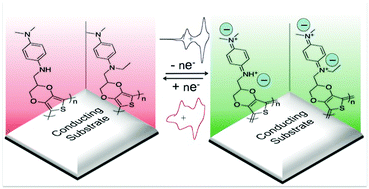The search for new materials for electrical energy storage (EES) is one of the most active research areas today. In terms of materials for electrochemical (super)capacitors, most work has focused on high surface area carbons (HSAC) (surface areas in excess of 2000 m2 g−1) and metal oxides (e.g. RuO2). These materials offer high charge/discharge rates but suffer from high cost in the case of metal oxides (RuO2) and/or low capacities (less than 10–20 mAh/g) for HSAC. Our work seeks to design materials with high specific capacity and high gravimetric energy and power densities. Conducting polymers are attractive as electrode materials for electrochemical capacitors due to their ability to store charge in a pseudo-capacitive manner and their insolubility in most organic solvents used as electrolytes. In fact, some devices based on conducting polymer materials have shown promise due to their fast doping/de-doping processes (e.g. polythiophenes). However the capacities of these polymeric materials are low when compared to inorganic battery materials, because the electrochemical reactions involve a fraction of an electron per monomer unit and the need for significant amounts of supporting electrolyte solution which lowers the gravimetric capacity and energy density. We have synthesized and thoroughly characterized hybrid organic-pendant/conducting-polymer composite materials (e.g. poly-3,4-ethylenedioxythiophene (PEDOT)/N,N,N′,N′-tetraalkylated-p-phenylenediamine composite) which can exchange up to 2.6 electrons per monomer unit. The materials can be electropolymerized, ostensibly through the EDOT units, to yield films capable of storing charge with contributions from both the conducting polymer (pseudocapacitor) and the organic pendant (faradaic). Early studies indicate good electrochemical cyclability.

You have access to this article
 Please wait while we load your content...
Something went wrong. Try again?
Please wait while we load your content...
Something went wrong. Try again?


 Please wait while we load your content...
Please wait while we load your content...